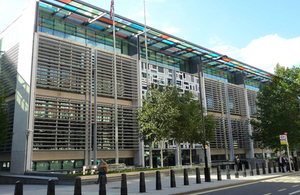Protect birds when building, says James Brokenshire
Developers have been reminded of their legal obligation to consider the impact of a project on local wildlife.

Developers must take more care to protect the habitats of wildlife during building work, Communities Secretary James Brokenshire MP warned today (8 April 2019).
Following increasing concern over netting being placed in trees and hedgerows ahead of building work near housing developments, developers have been reminded of their legal obligation to consider the impact of a project on local wildlife and where necessary, take precautionary action to protect their habitats.
In a letter to leading developers, the Communities Secretary emphasised that birds are protected under the Wildlife Countryside Act 1981, and that mitigation plans will need to show how developers will avoid or manage any negative effects on protected species during their work.
During building work, it is common practice for netting to be placed over trees and hedgerows, but this can be used unnecessarily and trap wildlife.
If developers do not follow their obligations, the Secretary of State has not ruled out further action to protect our country’s valuable ecological system.
The revised planning rulebook is also already clear that planning policies and decisions should contribute to and enhance the natural and local environment by minimising the impacts on and providing net gains for biodiversity.
But this government is going further, announcing plans to require developers to deliver biodiversity net gain through the forthcoming Environment Bill. This will mean habitats for wildlife must be left in a measurably better state than they were before any development.
The Communities Secretary Rt Hon James Brokenshire MP said:
Whilst building new homes is vital, we must take every care to avoid unnecessary loss of habitats that provide much-needed space for nature, including birds.
Developments should enhance natural environments, not destroy them. Netting trees and hedgerows is only likely to be appropriate where it is genuinely needed to protect birds from harm during development.
I hope developers will take these words on board and play their full role to make sure we can deliver new communities in an environmentally sustainable way.
Martin Harper, the RSPB’s director for conservation said:
We cannot keep trying to squeeze nature into smaller and smaller spaces or demand that wildlife fits in with our plans. Across the UK wildlife is vanishing at an alarming rate, and our planning system must play a vital role in not just reversing this decline but helping nature to recover.
Tree and hedge removal should be completed outside of nesting season. However, if there is absolutely no alternative, then netting must be used sparingly in line with the legal duties and responsibilities on developers, including regular checks to ensure wildlife isn’t getting trapped, injured or worse.
We are pleased to see the Secretary of State is acknowledging the concerns many people have about the use of netting, and how strongly we all feel about sharing our future neighbourhoods with nature rather than pushing it away.
Andrew Whitaker, planning director at the Home Builders Federation said:
Netting trees aligns with the relevant environmental requirements in instances where it has been agreed with the local authority that a tree has to be replaced. The industry is engaging with the RSPB to consider how we develop requirements that increase protections for wildlife whilst ensuring desperately needed homes are built without delay.
Last year housing developments incorporated around 9 million trees and shrubs making the industry one of the nation’s biggest providers of new trees.
As we build the homes the country needs, the industry is committed to supporting and enhancing bio-diversity, proactively protecting wildlife and providing an overall increase in the number of trees
Media enquiries
Email newsdesk@communities.gov.uk
Please use this number if you are a journalist wishing to speak to Press Office 0303 444 1209
Office address and general enquiries
2 Marsham StreetLondon
SW1P 4DF
Contact form https://www.gov.uk/gui...
General enquiries: please use this number if you are a member of the public 030 3444 0000
If your enquiry is related to COVID-19 please check our guidance page first before you contact us - https://www.gov.uk/guidance/coronavirus-covid-19-guidance-for-local-government.
If you still need to contact us please use the contact form above to get in touch, because of coronavirus (COVID-19). If you send it by post it will not receive a reply within normal timescale.
Social media - MHCLG
Twitter - https://twitter.com/mhclg
Flickr - http://www.flickr.com/photos/mhclg
LinkedIn - http://www.linkedin.com/company/mhclg